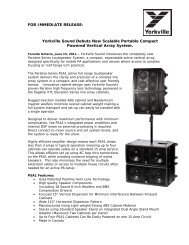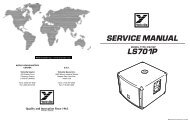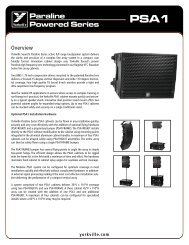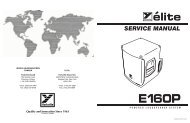owner's manual manuel de l'utilisateur - Yorkville Sound
owner's manual manuel de l'utilisateur - Yorkville Sound
owner's manual manuel de l'utilisateur - Yorkville Sound
Create successful ePaper yourself
Turn your PDF publications into a flip-book with our unique Google optimized e-Paper software.
8Digital Effects ProcessorThe internal Digital Effects Processor is afull 16 bit, 20kHz bandwidth DSP-base<strong>de</strong>ffects subsystem <strong>de</strong>veloped by AppliedResearch & Technology in Rochester,New York. It has been custom programmedwith 255 effects ranging fromreverb to echo and special effects.The selection of effects was <strong>de</strong>termined incollaboration with a panel of sound engineersexperienced in live performance mixing.The panel was asked to choose effects,which would be of the most practical usein actual, live performance situations. As aresult you will find the internal system to bemore than a<strong>de</strong>quate for most applicationEFX Footswitch/Send JackA standard on/off footswitch (optional)plugged into this jack will enable you toturn the internal effects system on and off.Optionally, this jack may be employed tofeed the EFX signal to an external effectsunit the output of which could be returnedvia an input channel - perhaps channel9/10 or 11/12 if the effects unit is stereo. Inthis mo<strong>de</strong>, the channel fa<strong>de</strong>r would become the master effects return control, thereforebe sure to set that fa<strong>de</strong>r fairly low and adjust to <strong>de</strong>sired levels. Be sure to turn theEFX send control off in or<strong>de</strong>r to avoid creating a loop. Also, be sure to pull the EFXMASTER fa<strong>de</strong>r down to the off position.Phones Jack, Level Control & SourcesThe PHONES jack accepts standard stereo headphones and is located in the upperright area of the panel. The PHONES level control is located in the lower right area.The source for all headphone signals is the MONitor bus until a CUE button is<strong>de</strong>pressed at which time only the cued channel can be heard through the phones.Level MetersThese meters follow either the Left and Right MAIN bus activities or a mono mix ofthe mains on the Left-meter and monitors on the Right-meter, all <strong>de</strong>pending on theposition of the EQ/AMP ASSIGN button. If either or both CLIP lights at the top of thelevel meters is flashing too much of the time, lower the appropriate MAIN MASTERlevel to avoid possible distortion on peaks.Amp 1 & 2 InputsThese are switching jacks, which enable you to directly access either or both channelsof the built-in power amplifier while disconnecting them from normal internalfunctions. This permits you to insert an external-EQ, a processor/crossover (e.g. élite)or a compressor/limiter between the mixer section’s POST EQ LINE OUTPUTS andthe AMP 1 & AMP 2 INPUTS thus providing the 100% signal processing essential forthese functions to work properly.User tip: If you have an electronic-crossover or processor/crossover, you can drivesubwoofers and full-range cabinets in a biamped system with the AP312. The hookupgoes as follows:1. With the EQ/AMP ASSIGN button down in the MAIN/MON position, run a patchcable from the POST EQ MAIN (L) LINE OUTPUT to the input on an electroniccrossover/processor.2. Now run a second patch cable from the low-frequency or subwoofer output onthe crossover to the AP312’s AMP 1 INPUT and a third patch cable from thecrossover’s high-frequency or full-range output to the AP312’s AMP 2 INPUT.
















